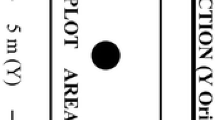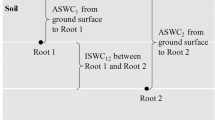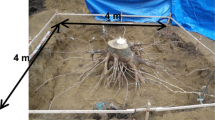Abstract
Aim
Ground penetrating radar (GPR) as a non-invasive technique is widely used in coarse root detection. However, the applicability of the technique to detect fine roots of agricultural crops is unknown. The objective of this study was to assess the feasibility of utilizing GPR to detect fine roots in the field.
Methods
This study was conducted in four locations with different soil types and soil moisture conditions in Texas. Several varieties of winter wheat and energy cane were scanned with GPR (1600 MHz). Soil cores were collected immediately after scanning to measure root parameters. Using an image analysis software, four pixel indices with or without intensity threshold were used to assess the relationships between GPR signal and root parameters.
Results
There were significant relations between GPR indices and root parameters depending on soil conditions. The accuracy of root estimation was higher in wet clay soils than in dry sandy soils. Estimated root parameters from GPR had lower variation than measured roots. Average GPR pixel intensity without intensity threshold may be better to reflect root information than pixel indices with intensity threshold.
Conclusions
This study demonstrates that GPR has the potential to predict bulk root biomass and diameter in winter wheat and energy cane.




Similar content being viewed by others
Abbreviations
- GPR:
-
Ground penetrating radar
- NRMSE:
-
Normalized root mean square error
- GSSI:
-
Geophysical Survey Systems, Inc.
References
al Hagrey SA (2007) Geophysical imaging of root-zone, trunk, and moisture heterogeneity. J Exp Bot 58:839–854. https://doi.org/10.1093/jxb/erl237
al Hagrey SA, Müller C (2000) GPR study of pore water content and salinity in sand. Geophys Prospect 48:63–85. https://doi.org/10.1046/j.1365-2478.2000.00180.x
Barton CVM, Montagu KD (2004) Detection of tree roots and determination of root diameters by ground penetrating radar under optimal conditions. Tree Physiol 24:1323–1331. https://doi.org/10.1093/treephs/24.12.1323
Benedetto A (2010) Water content evaluation in unsaturated soil using GPR signal analysis in the frequency domain. J Appl Geophys 71:26–35. https://doi.org/10.1016/j.jappgeo.2010.03.001
Benedetto F, Tosti F (2013) GPR spectral analysis for clay content evaluation by the frequency shift method. J Appl Geophys 97:89–96. https://doi.org/10.1016/j.jappgeo.2013.03.012
Blum A (2005) Drought resistance, water-use efficiency, and yield potential –- are they compatible, dissonant, or mutually exclusive? Aust J Agric Res 56:1159–1168. https://doi.org/10.1071/AR05069
Bodner G, Leitner D, Kaul H-P (2014) Coarse and fine root plants affect pore size distributions differently. Plant Soil 380:133–151. https://doi.org/10.1007/s11104-014-2079-8
Borden KA, Isaac ME, Thevathasan NV, Gordon AM, Thomas SC (2014) Estimating coarse root biomass with ground penetrating radar in a tree-based intercropping system. Agrofor Syst 88:657–669. https://doi.org/10.1007/s10457-014-9722-5
Butnor J (2011) Monitoring tree roots over time with GPR. Symposium on the application of geophysics to engineering and environmental problems 2011. Soc Explor Geophys. https://doi.org/10.4133/1.3614086
Butnor JR, Doolittle J, Kress L, Cohen S, Johnsen KH (2001) Use of ground-penetrating radar to study tree roots in the southeastern United States. Tree Physiol 21:1269–1278. https://doi.org/10.1093/treephs/21.17.1269
Butnor JR, Doolittle J, Johnsen KH, Samuelson L, Stokes T, Kress L (2003) Utility of ground-penetrating radar as a root biomass survey tool in forest systems. Soil Sci Soc Am J 67:1607–1615. https://doi.org/10.2136/sssaj2003.1607
Butnor J, Roth B, Johnsen K (2005) Feasibility of using ground-penetrating radar to quantify root mass in Florida's intensively managed pine plantations. FBRC Report #38
Butnor JR, Barton C, Day FP, Johnsen KH, Mucciardi AN, Schroeder R, Stover DB (2012) Using ground-penetrating radar to detect tree roots and estimate biomass. In: Mancuso S (ed) Measuring roots. Springer Berlin, Heidelberg, pp. 213–245. https://doi.org/10.1007/978-3-642-22067-8_12
Butnor JR, Samuelson LJ, Stokes TA, Johnsen KH, Anderson PH, González-Benecke CA (2016) Surface-based GPR underestimates below-stump root biomass. Plant Soil 402:47–62. https://doi.org/10.1007/s11104-015-2768-y
Carminati A, Moradi AB, Vetterlein D, Vontobel P, Lehmann E, Weller U, Vogel H-J, Oswald SE (2010) Dynamics of soil water content in the rhizosphere. Plant Soil 332:163–176. https://doi.org/10.1007/s11104-010-0283-8
Clark RT, MacCurdy RB, Jung JK, Shaff JE, McCouch SR, Aneshansley DJ, Kochian LV (2011) Three-dimensional root phenotyping with a novel imaging and software platform. Plant Physiol 156:455–465. https://doi.org/10.1104/pp.110.169102
Cox K, Scherm H, Serman N (2005) Ground-penetrating radar to detect and quantify residual root fragments following peach orchard clearing. HortTechnology 15:600–607
Cui X, Chen J, Shen J, Cao X, Chen X, Zhu X (2011) Modeling tree root diameter and biomass by ground-penetrating radar. Sci China Earth Sci 54:711–719. https://doi.org/10.1007/s11430-010-4103-z
Daniels DJ (2004) Ground penetrating radar. The Institution of Engineering and Technology; 2nd edition. 752 pages
Delgado A, Hays DB, Bruton RK, Ceballos H, Novo A, Boi E, Selvaraj MG (2017) Ground penetrating radar: a case study for estimating root bulking rate in cassava (Manihot esculenta Crantz). Plant Methods 13:65. https://doi.org/10.1186/s13007-017-0216-0
Dong X, Patton BD, Nyren AC, Nyren PE, Prunty LD (2010) Quantifying root water extraction by rangeland plants through soil water modeling. Plant Soil 335:181–198. https://doi.org/10.1007/s11104-010-0401-7
Doolittle JA, Collins ME (1995) Use of soil information to determine application of ground penetrating radar. J Appl Geophys 33:101–108. https://doi.org/10.1016/0926-9851(95)90033-0
Gormally KH, McIntosh MS, Mucciardi AN, McCarty GW (2011) Ground-penetrating radar detection and three-dimensional mapping of lateral macropores: II. Riparian application. Soil Sci Soc Am J 75:1236–1243. https://doi.org/10.2136/sssaj2010.0342
Guo L, Chen J, Cui X, Fan B, Lin H (2013a) Application of ground penetrating radar for coarse root detection and quantification: a review. Plant Soil 362:1–23. https://doi.org/10.1007/s11104-012-1455-5
Guo L, Lin H, Fan B, Cui X, Chen J (2013b) Impact of root water content on root biomass estimation using ground penetrating radar: evidence from forward simulations and field controlled experiments. Plant Soil 371:503–520. https://doi.org/10.1007/s11104-013-1710-4
Hirano Y, Dannoura M, Aono K, Igarashi T, Ishii M, Yamase K, Makita N, Kanazawa Y (2009) Limiting factors in the detection of tree roots using ground-penetrating radar. Plant Soil 319:15–24. https://doi.org/10.1007/s11104-008-9845-4
Hruška J, Čermák J, Sustek S (1999) Mapping tree root systems with ground-penetrating radar. Tree Physiol 19:125–130. https://doi.org/10.1093/treephs/19.2.125
Kell DB (2011) Breeding crop plants with deep roots: their role in sustainable carbon, nutrient and water sequestration. Ann Bot 108:407–418. https://doi.org/10.1093/aob/mcr175
Liu X, Zhang X, Chen S, Sun H, Shao L (2015) Subsoil compaction and irrigation regimes affect the root–shoot relation and grain yield of winter wheat. Agr Water Manage 154:59–67. https://doi.org/10.1016/j.agwat.2015.03.004
Liu X, Dong X, Leskovar DI (2016a) Ground penetrating radar for underground sensing in agriculture: a review. Int Agrophys 30:533–543. https://doi.org/10.1515/intag-2016-0010
Liu X, Feike T, Shao L, Sun H, Chen S, Zhang X (2016b) Effects of different irrigation regimes on soil compaction in a winter wheat–summer maize cropping system in the North China Plain. Catena 137:70–76. https://doi.org/10.1016/j.catena.2015.08.014
Lukac M (2012) Fine root turnover. In: Mancuso S (ed) Measuring roots. Springer Berlin, Heidelberg, pp. 363–373
Majdi H (1996) Root sampling methods-applications and limitations of the minirhizotron technique. Plant Soil 185:255–258. https://doi.org/10.1007/BF02257530
Mooney SJ, Pridmore TP, Helliwell J, Bennett MJ (2012) Developing X-ray computed tomography to non-invasively image 3-D root systems architecture in soil. Plant Soil 352:1–22. https://doi.org/10.1007/s11104-011-1039-9
Moore G, Ryder C (2015) The use of ground-penetrating radar to locate tree roots. Arbori Urban For 41:245–259
Oswald SE, Menon M, Carminati A, Vontobel P, Lehmann E, Schulin R (2008) Quantitative imaging of infiltration, root growth, and root water uptake via neutron radiography. Vadose Zone J 7:1035–1047. https://doi.org/10.2136/vzj2007.0156
Paez-Garcia A, Motes CM, Scheible W-R, Chen R, Blancaflor EB, Monteros MJ (2015) Root traits and phenotyping strategies for plant improvement. Plants 4:334–355. https://doi.org/10.3390/plants4020334
Pauli D, Chapman SC, Bart R, Topp CN, Lawrence-Dill CJ, Poland J, Gore MA (2016) The quest for understanding phenotypic variation via integrated approaches in the field environment. Plant Physiol 172:622–634. https://doi.org/10.1104/pp.16.00592
Peng X, Horn R (2007) Anisotropic shrinkage and swelling of some organic and inorganic soils. Eur J Soil Sci 58:98–107. https://doi.org/10.1111/j.1365-2389.2006.00808.x
Pierret A, Moran CJ, Doussan C (2005) Conventional detection methodology is limiting our ability to understand the roles and functions of fine roots. New Phytol 166:967–980. https://doi.org/10.1111/j.1469-8137.2005.01389.x
Raper RL, Asmussen L, Powell JB (1990) Sensing hard pan depth with ground-penetrating radar. T ASAE 33:41–46. https://doi.org/10.13031/2013.31291
Sharma SP, Leskovar DI, Crosby KM, Volder A, Ibrahim AMH (2014) Root growth, yield, and fruit quality responses of reticulatus and inodorus melons (Cucumis melo L.) to deficit subsurface drip irrigation. Agr Water Manage 136:75–85. https://doi.org/10.1016/j.agwat.2014.01.008
Shih SF, Doolittle JA (1984) Using radar to investigate organic soil thickness in the Florida Everglades1. Soil Sci Soc Am J 48:651–656. https://doi.org/10.2136/sssaj1984.03615995004800030036x
Swinnen J, Van Veen J, Merckx R (1995) Root decay and turnover of rhizodeposits in field-grown winter wheat and spring barley estimated by 14C pulse-labelling. Soil Biol Biochem 27:211–217. https://doi.org/10.1016/0038-0717(94)00161-S
Thomas CL, Graham N, Hayden R, Meacham MC, Neugebauer K, Nightingale M, Dupuy LX, Hammond JP, White PJ, Broadley MR (2016) High-throughput phenotyping (HTP) identifies seedling root traits linked to variation in seed yield and nutrient capture in field-grown oilseed rape (Brassica napus L.) Ann Bot 118:655–665. https://doi.org/10.1093/aob/mcw046
Thompson SM (2014) Evaluation of terrestrial laser scanning and ground penetrating radar for field-based high-throughput phenotyping in wheat breeding. Dissertation, Texas A&M University
Trachsel S, Kaeppler SM, Brown KM, Lynch JP (2011) Shovelomics: high throughput phenotyping of maize (Zea mays L.) root architecture in the field. Plant Soil 341:75–87. https://doi.org/10.1007/s11104-010-0623-8
Urban J, Bequet R, Mainiero R (2011) Assessing the applicability of the earth impedance method for in situ studies of tree root systems. J Exp Bot 62:1857–1869. https://doi.org/10.1093/jxb/erq370
Vereecken H, Kamai T, Harter T, Kasteel R, Hopmans J, Vanderborght J (2007) Explaining soil moisture variability as a function of mean soil moisture: a stochastic unsaturated flow perspective. Geophys Res Lett 34:L22402. https://doi.org/10.1029/2007GL031813
Wasson AP, Richards R, Chatrath R, Misra S, Prasad SS, Rebetzke G, Kirkegaard J, Christopher J, Watt M (2012) Traits and selection strategies to improve root systems and water uptake in water-limited wheat crops. J Exp Bot 63:3485–3498. https://doi.org/10.1093/jxb/ers111
Weigand M, Kemna A (2017) Multi-frequency electrical impedance tomography as a non-invasive tool to characterize and monitor crop root systems. Biogeosciences 14:921–939. https://doi.org/10.5194/bg-14-921-2017
Wielopolski L, Hendrey G, Daniels J, McGuigan M (2000) Imaging tree root systems in situ. Proc SPIE Int Soc Opt Eng 4084:642–646. https://doi.org/10.1117/12.383538
Wu J, Zhang R, Gui S (1999) Modeling soil water movement with water uptake by roots. Plant Soil 215:7–17. https://doi.org/10.1023/A:1004702807951
Xue Q, Zhu Z, Musick J, Stewart B, Dusek D (2003) Root growth and water uptake in winter wheat under deficit irrigation. Plant Soil 257:151–161. https://doi.org/10.1023/A:1026230527597
Yadav BK, Mathur S, Siebel MA (2009) Soil moisture dynamics modeling considering the root compensation mechanism for water uptake by plants. J Hydrol Eng 14:913–922. https://doi.org/10.1061/(ASCE)HE.1943-5584.0000066
Yeung SW, Yan WM, Hau CHB (2016) Performance of ground penetrating radar in root detection and its application in root diameter estimation under controlled conditions. Sci China Earth Sci 59:145–155. https://doi.org/10.1007/s11430-015-5156-9
York LM (2014) Integration of root phenes affecting nitrogen acquisition in maize (Zea mays). Dissertation, The Pennsylvania State University
York LM, Lynch JP (2015) Intensive field phenotyping of maize (Zea mays L.) root crowns identifies phenes and phene integration associated with plant growth and nitrogen acquisition. J Exp Bot 66:5493–5505. https://doi.org/10.1093/jxb/erv241
York LM, Carminati A, Mooney SJ, Ritz K, Bennett MJ (2016) The holistic rhizosphere: integrating zones, processes, and semantics in the soil influenced by roots. J Exp Bot 67:3629–3643. https://doi.org/10.1093/jxb/erw108
Zhang X, Chen S, Sun H, Wang Y, Shao L (2009) Root size, distribution and soil water depletion as affected by cultivars and environmental factors. Field Crop Res 114:75–83. https://doi.org/10.1016/j.fcr.2009.07.006
Zhang Y, Shen Y, Sun H, Gates JB (2011) Evapotranspiration and its partitioning in an irrigated winter wheat field: a combined isotopic and micrometeorologic approach. J Hydrol 408:203–211. https://doi.org/10.1016/j.jhydrol.2011.07.036
Acknowledgements
The authors express thanks to Mr. Shane Sieckenius and Mr. Dalton Thompson at the Uvalde Research Center and Mr. Kirk Jessup at the Amarillo Research Center for assistance in carrying out much of the field work, as well as Dr. Subas Malla for internal review. We also thank Mr. Jaime Lopez at the Frio County Extension Service for help in identifying field sampling locations. Support for this study was provided in part by the Texas A&M AgriLife Research cropping system seed grant entitled “Root-shoot phenotyping and water balance characterization to improve water use efficiency and productivity of cropping systems in Texas” and also by an Agriculture and Food Research Initiative Competitive Grant # 2013-67009-21353 titled “A Water and Risk Management Tool for Sustainable Production of Bioenergy Feed stocks” from the USDA National Institute of Food and Agriculture.
Author information
Authors and Affiliations
Corresponding author
Additional information
Responsible Editor: Alexia Stokes.
Rights and permissions
About this article
Cite this article
Liu, X., Dong, X., Xue, Q. et al. Ground penetrating radar (GPR) detects fine roots of agricultural crops in the field. Plant Soil 423, 517–531 (2018). https://doi.org/10.1007/s11104-017-3531-3
Received:
Accepted:
Published:
Issue Date:
DOI: https://doi.org/10.1007/s11104-017-3531-3




